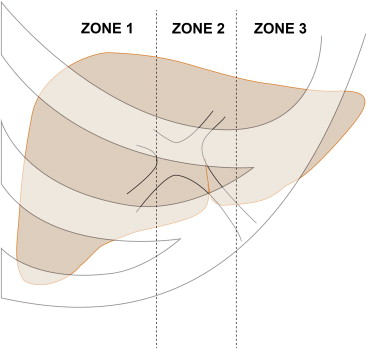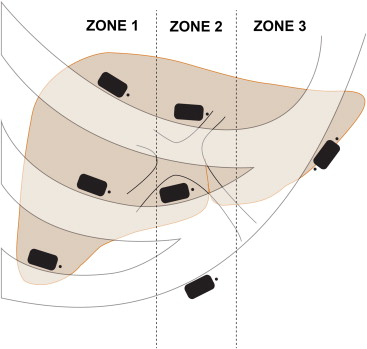Rationale and Objectives
The goal of this study is to emphasize the value of lesion-focused approach in ultrasonography (US)-guided solid liver lesion biopsies performed under our guidance.
Materials and Methods
In our retrospective study, after the standard preparation for US-guidance solid liver lesion biopsy was accomplished, we performed standard intercostal approach and the biopsy procedure though one of our patients experienced a major complication (pneumothorax). After this undesirable case, we reviewed our biopsy procedure and performed a lesion-focused approach technique as described in this article. A Tru-cut biopsy gun (18 gauge) was used in this trial. The liver biopsies were divided into two groups according to the biopsy technique and all results were compared with each other.
Results
A total of 202 solid liver lesion biopsies were was performed under the guidance of US between October 2007 and July 2010. One major complication occurred in first group. All of the minor complications occurred in the first group. In group 2, there were no complications. For this reason, all patients in group 2 were discharged home after a few hours. Patients with minor complications in the first group were observed an average of 6 hours. Adequate tissue for pathological diagnosis was similar in both groups.
Conclusion
The lesion-focused approach technique has the potential to reduce both complication rates and patient incompliance. Percutaneous liver biopsies performed with this technique using real-time US guidance are convincing and clinically beneficial.
Percutaneous liver biopsy (PLB) is considered one of the most important diagnostic tools when diagnosing and managing patients with liver disease. PLB is a well-established, widely, and routinely used procedure with low morbidity. However, it is invasive and carries small risks for serious complications .
Although blind percutaneous needle biopsy is the traditional technique, the use of ultrasound (US) guidance has increased considerably. The existing clinical practice of PLB considerably varies with an emphasis on the technique, the operator, types of biopsy needles, quality of biopsy specimens and the risk of complications . Because of these significant alterations in the practice, complication rates and biopsy material adequacy may show a discrepancy among practitioners.
Get Radiology Tree app to read full this article<
Materials and methods
Study Design
Get Radiology Tree app to read full this article<
Coagulation Studies
Get Radiology Tree app to read full this article<
The Biopsy Needle
Biopsy procedure
Get Radiology Tree app to read full this article<
Get Radiology Tree app to read full this article<
Get Radiology Tree app to read full this article<
Get Radiology Tree app to read full this article<
Get Radiology Tree app to read full this article<
Get Radiology Tree app to read full this article<
Get Radiology Tree app to read full this article<
Get Radiology Tree app to read full this article<
Get Radiology Tree app to read full this article<
Get Radiology Tree app to read full this article<
Get Radiology Tree app to read full this article<
After the biopsy
Get Radiology Tree app to read full this article<
Result
Get Radiology Tree app to read full this article<
Get Radiology Tree app to read full this article<
Get Radiology Tree app to read full this article<
Get Radiology Tree app to read full this article<
Get Radiology Tree app to read full this article<
Table 1
Analysis of Patients According to the Type of Pathologies
Group 1 ( n = 89) Group 2 ( n = 113) Metastasis 51 54 Hepatocellular carcinoma 29 24 Others 3 28 Insufficient material 6 7 Total 89 113
Get Radiology Tree app to read full this article<
Get Radiology Tree app to read full this article<
Discussion
Get Radiology Tree app to read full this article<
Get Radiology Tree app to read full this article<
Get Radiology Tree app to read full this article<
Get Radiology Tree app to read full this article<
Get Radiology Tree app to read full this article<
Get Radiology Tree app to read full this article<
Conclusion
Get Radiology Tree app to read full this article<
References
1. Appelbaum L., Kane R.A., Kruskal J.B., et. al.: Focal hepatic lesions: US-guided biopsy—lessons from review of cytologic and pathologic examination results. Radiology 2009; 250: pp. 453-458.
2. Yu S.C., Liew C.T., Lau W.Y., et. al.: US-guided percutaneous biopsy of small (< or = 1-cm) hepatic lesions. Radiology 2001; 218: pp. 195-199.
3. Saloura E.A., Bizimi V., Theodoropoulos E., et. al.: Focal hepatic lesion ultrasound-guided biopsies. Med Ultrason 2010; 12: pp. 295-299.
4. Hoosein M.M., Barnes D., Khan A.N., et. al.: The importance of ultrasound in staging and gaining a pathological diagnosis in patients with lung cancer—a two year single centre experience. Thorax 2011; 66: pp. 414-417.
5. Lipp M.J., D’Souza L.S., Clain D.J., et. al.: Trends in the indication and method of liver biopsy for hepatitis B and C. Dig Dis Sci 2010; 55: pp. 2971-2976.
6. Zinzani P.L., Colecchia A., Festi D., et. al.: Ultrasound-guided core-needle biopsy is effective in the initial diagnosis of lymphoma patients. Haematologica 1998; 83: pp. 989-992.
7. Akkan Cetinkaya Z., Sezikli M., et. al.: Liver biopsy: ultrasonography guidance is not superior to the blind method. J Gastrointestin Liver Dis 2010; 19: pp. 49-52.
8. Lindor K.D., Bru C., Jorgensen R.A., et. al.: The role of ultrasonography and automatic-needle biopsy in outpatient percutaneous liver biopsy. Hepatology 1996; 23: pp. 1079-1083.
9. Gilmore I.T., Burroughs A., Murray-Lyon , et. al.: Indications, methods, and outcomes of percutaneous liver biopsy in England and Wales: an audit by the British Society of Gastroenterology and the Royal College of Physicians of London. Gut 1995; 36: pp. 437-441.
10. Jacobs W.H., Goldberg S.B.: Statement on outpatient percutaneous liver biopsy. Dig Dis Sci 1989; 34: pp. 322-323.
11. Manolakopoulos S., Triantos C., Bethanis S., et. al.: Ultrasound guided liver biopsy in real life: comparison of same-day prebiopsy versus real-time ultrasound approach. J Gastroenterol Hepatol 2007; 22: pp. 1490-1493.
12. Cevik F.C., Aykin N., Naz H.: Complications and efficiency of liver biopsies using the Tru-Cut biopsy Gun. J Infect Dev Ctries 2010; 4: pp. 91-95.
13. Piccinino F., Sagnelli E., Pasquale G., et. al.: Complications following percutaneous liver biopsy. J Hepatol 1986; 2: pp. 165-173.

